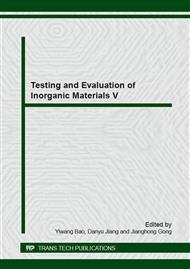p.173
p.179
p.183
p.189
p.193
p.198
p.204
p.210
p.214
Microstructure and Properties of Al2O3-ZrO2 Ceramics Prepared by Microwave Sintering
Abstract:
ZrO2 doped with 7.5% (volume percent) nanoalumina ceramics were prepared by microwave sintering processes. The effects of nanoalumina additions and various sintering temperature on densification, phase composition, microstructure and mechanical properties of Al2O3-ZrO2 ceramics were investigated. The results show that the m-ZrO2 phase transformed into t-ZrO2 during the process of microwave sintering. Relative densities between 95% and 99% were attained in the different conditions. In any cases the grain size was maintained at a submicron scale at a processing microwave sintering. The presence of Al2O3 grains had an effect of hindering grain growth of ZrO2 grains. When the microwave sintering temperature was 1500°C, 7.5Al2O3-ZrO2 composite ceramics presented excellent mechanical properties: HV=12.0 GPa, σf=715.7 Mpa, KIC=11.9 MPa·m1/2. Compared with that of pure ZrO2 ceramic, the bending strength and the fracture toughness were improved 45% and 23% at least, respectively. The fracture mode was associated with sintering temperature: when the sintering temperature was 1350°C~1450°C, the intergranular fracture and transgranular fracture coexisted; when the sintering temperature was 1500°C, intergranular fracture was the main fracture mode.
Info:
Periodical:
Pages:
193-197
Citation:
Online since:
November 2014
Authors:
Keywords:
Price:
Сopyright:
© 2015 Trans Tech Publications Ltd. All Rights Reserved
Share:
Citation:


